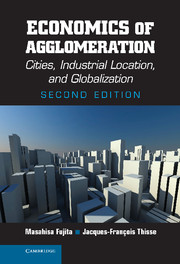Book contents
- Frontmatter
- Dedication
- Contents
- Acknowledgments
- Preface to the Second Edition
- 1 Agglomeration and Economic Theory
- Part I Fundamentals of Spatial Economics
- Part II The Structure of Metropolitan Areas
- Part III Factor Mobility and Industrial Location
- 8 Industrial Agglomeration under Monopolistic Competition
- 9 Market Size and Industrial Clusters
- Part IV Urban Systems, Regional Growth, and the Multinationalization of Firms
- References
- Author Index
- Subject Index
8 - Industrial Agglomeration under Monopolistic Competition
Published online by Cambridge University Press: 05 August 2013
- Frontmatter
- Dedication
- Contents
- Acknowledgments
- Preface to the Second Edition
- 1 Agglomeration and Economic Theory
- Part I Fundamentals of Spatial Economics
- Part II The Structure of Metropolitan Areas
- Part III Factor Mobility and Industrial Location
- 8 Industrial Agglomeration under Monopolistic Competition
- 9 Market Size and Industrial Clusters
- Part IV Urban Systems, Regional Growth, and the Multinationalization of Firms
- References
- Author Index
- Subject Index
Summary
INTRODUCTION
At the interregional or international level, the spatial economy is replete with pecuniary externalities. For example, when workers choose to migrate, they bring with them both their production and consumption capabilities. As a result, their movements affect the size of labor and product markets in both the origin and destination regions. These effects have the nature of pecuniary externalities because migrating workers do not take them into account in their decisions. Pecuniary externalities are especially relevant when markets are imperfectly competitive because prices do not perfectly reflect the social values of individual decisions. The effects generated by migrations are better studied within a general equilibrium framework that accounts for the interactions between the product and labor markets. Among other things, this allows studying the dual role of individuals as workers and consumers. At first sight, this seems to be a formidable task. Yet, as shown by Krugman (1991b), several of these various effects can be combined and studied within a relatively simple general equilibrium model of monopolistic competition, which has come to be known as the core-periphery (CP) model.
Recall that monopolistic competition a la Chamberlin (1933) involves consumers with a preference for variety (varietas delectat), whereas firms producing these varieties compete for a limited amount of resources because they face increasing returns. The prototype that has emerged from the industrial organization literature is the constant elasticity of substitution (CES) model developed by Dixit and Stiglitz (1977).
- Type
- Chapter
- Information
- Economics of AgglomerationCities, Industrial Location, and Globalization, pp. 285 - 345Publisher: Cambridge University PressPrint publication year: 2013

